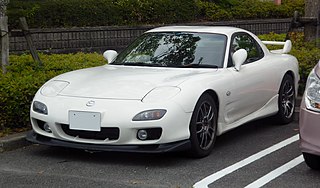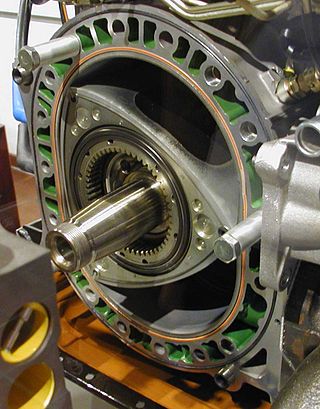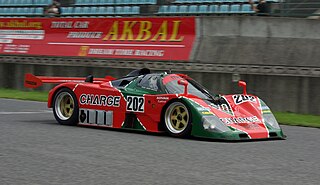Related Research Articles

Mazda Motor Corporation, commonly referred to as simply Mazda, is a Japanese multinational automotive manufacturer headquartered in Fuchū, Hiroshima, Japan.

The Wankel engine is a type of internal combustion engine using an eccentric rotary design to convert pressure into rotating motion. It was invented by German engineer Felix Wankel, and designed by German engineer Hanns-Dieter Paschke. The Wankel engine's rotor, which creates the turning motion, is similar in shape to a Reuleaux triangle, with the sides having less curvature. The rotor rotates inside an oval-like epitrochoidal housing, around a central output shaft. The rotor spins in a hula-hoop fashion around the central output shaft, spinning the shaft via toothed gearing.

The Mazda RX-7 is a front-engine, rear-wheel-drive, rotary engine-powered sports car that was manufactured and marketed by Mazda from 1978 until 2002 across three generations, all of which made use of a compact, lightweight Wankel rotary engine.

The Chevrolet Monza is a subcompact automobile produced by Chevrolet for the 1975 through 1980 model years. The Monza is based on the Chevrolet Vega, sharing its wheelbase, width, and standard inline-four engine. The car was designed to accommodate the GM-Wankel rotary engine, but due to mediocre fuel economy and emissions-compliance issues the engine was cancelled, and a V8 engine option was substituted. The Monza name has also been used for several other cars.

The Mazda Wankel engines are a family of Wankel rotary combustion car engines produced by Mazda.

The Mazda 787 and its derivative 787B are Group C sports prototype racing cars that were developed by Japanese automobile manufacturer Mazda for use in the World Sportscar Championship, All Japan Sports Prototype Championship, and the 24 Hours of Le Mans from 1990 to 1991. Designed to combine a mixture of the Fédération Internationale du Sport Automobile (FISA) Group C regulations with the International Motor Sports Association (IMSA) GTP regulations, the 787s were the last Wankel rotary-powered racing cars to compete in the World and Japanese championships, using Mazda's R26B engine.

The Mazda 767/767B are prototype racing cars that were built by Mazdaspeed for the 24 Hours of Le Mans running under the IMSA-spec GTP class. The 767 replaced the 757 in 1988, upgrading to a newer and larger 4-rotor 13J Wankel engine which produced nearly 600 hp (450 kW).

Group C was a category of sports car racing introduced by the FIA in 1982 and continuing until 1993, with Group A for touring cars and Group B for GTs.

The General Motors Rotary Combustion Engine (GMRCE) is an internal combustion Wankel engine which uses a rotary design to convert pressure into a rotating motion instead of using reciprocating pistons. In November 1970, GM paid $50 million, ($348,886,033 in 2021 dollars ), for initial licenses to produce their version of the Wankel rotary engine, and GM President Ed Cole initially projected its release in three years. Chevrolet, with impetus from Pete Estes and John DeLorean, as well as Ed Cole worked on the Wankel. Bob Templin was the chief executive in charge of rotary-engine research at the GM Tech Center in Warren, Michigan, but Ed Cole would leave his office in Detroit twice a week for the trip to Warren, taking charge of the program. The engine was initially targeted for an October 1973 introduction as a 1974 Chevrolet Vega option. Its mediocre fuel economy and the ill-timed Arab oil embargo were contributing factors to end the GM rotary program.
The Lola T616 is a sports prototype built by Lola Cars to the Group C2 and IMSA GTP regulations. It was built with the intention to compete in the IMSA GT Championship and the World Sportscar Championship, and became the second Mazda-powered prototype to score a class win at the 24 Hours of Le Mans after the 717C triumphed in the same C2 class at the 1983 24 Hours of Le Mans.
The Mazda GTP is an IMSA GTP race car that was built by Pierre Honegger in 1981. Based on a Mazda RX-7, the car initially competed in the GTX category as the Mazda RX-7 GTP, before it was rebuilt for the IMSA GTP category in 1983. Throughout its career, the car used a Mazda 13B Wankel rotary engine, similar to that used in the production RX-7s. Although the rotary-engined sports prototypes generally had a reputation of being very reliable, the Mazda GTP frequently failed to finish races, and was never able to better the eighth place achieved at the 1983 24 Hours of Daytona. In 1986, one car was purchased by Erie Scientific Racing, and rebuilt to become the Badger BB. This car was no more successful or reliable than its predecessor, and was last used in 1989, by which point it was owned by Jack Engelhardt. The other car, meanwhile, was rebuilt by Honegger into the Denali Speedcar, which was used with moderate success in 1986 and 1987.

The Buick Indy V6 engine is a powerful turbocharged, 3.0–3.4 L (180–210 cu in), V-6, Indy car racing internal combustion engine, designed and produced by Buick for use in the C.A.R.T. PPG Indy Car World Series, and later the IRL IndyCar Series; between 1982 and 1997. It shares the same architecture, and mechanical design, and is based on the Buick V6 road car engine. A slightly destroked 3.0-liter V6 engine was also used in the March 85G and March 86G IMSA GTP sports prototypes.

The March 84G was a mid-engined Group C and IMSA racing sports prototype, designed and developed by March Engineering in late 1983 and used in sports car racing until 1989. It was powered by a number of different engines, including a Chevrolet small-block, a Buick V6, a Porsche flat-six, and even a Mazda 13B Wankel rotary engine. Power output was around 620 hp (460 kW). It only managed to score 5 wins, and clinch a total of 10 podium, over the course of 7 years and 119 race entries.
The Ford Probe GTP, also sometimes called the Ford Mustang Probe GTP, was an IMSA GTP sports racing car, designed, developed and built by German constructor Zakspeed, and used by the Zakspeed Racing team in the 1985 IMSA GT Championship. It was based on the standard road-going Ford Probe, and was the successor to the Ford Mustang GTP race car.. Unlike the road car, using a conventional front-engined designed, the prototype race car used a mid-engined design. It was powered by the same 2.1 L (130 cu in) turbocharged Cosworth BDA straight-four engine, producing 600 hp (450 kW), which was plenty powerful enough for the lightweight 1,770 lb (800 kg) vehicle. This drove the rear wheels through a five-speed Hewland VG5 manual transmission. Klaus Ludwig, Doc Bundy, Lyn St. James, Scott Pruett, Pete Halsmer, Arie Luyendyk, Tom Gloy, and Chip Robinson all drove the car. Highlights for the car included two second-place podium finishes at Watkins Glen and Sears Point in 1985, and an outright win for Klaus Ludwig at Laguna Seca in 1986.

The Argo JM19, and its derivatives/evolutions, the Argo JM19C, and the Argo JM19D, are a series of IMSA GTP Lights/Group C2 sports prototype, designed, developed, and built by British constructor Argo Racing Cars, for the IMSA GT Championship, introduced in 1985. Its use in sports car racing continued into the early 1990s. It won a total of 7 races, and scored a total of 21 podium finishes. It was powered by a number of different engines, including a Mazda 13B rotary engine, a Buick V6 turbo engine, a Ferrari V8 engine, and even a Ford-Cosworth DFL V8 Formula One-derived engine. It did, however, find most of its success when equipped with the Mazda-powered Wankel rotary engines.
The Argo JM16 is an IMSA GTP Lights sports prototype race car, designed, developed and built by Argo Racing Cars, in 1984. It competed in the IMSA GT Championship sports car racing series between 1984 and 1993. It, unfortunately, did not win any races, however, it did achieve 11 class victories, and one 3rd-place podium finish. It was powered by three different naturally aspirated engines; a Ford-Cosworth DFV Formula One engine, a Buick V6, and a Mazda 13B Wankel 2-rotor engine.
The Kudzu DG-1 is an IMSA GTP Lights sports prototype race car, designed, developed and built by American racing driver Jim Downing; making its debut in 1989. It competed in the IMSA GT Championship between 1989 and 1993. It was powered by either a Mazda 13B Wankel rotary engine, or a Buick V6 engine. Its best result was a 5th-place finish, and it achieved 4 class wins.
The Kudzu DG-2 is an IMSA GTP Lights sports prototype race car, designed, developed and built by American racing driver Jim Downing, to compete in sports car racing, between 1992 and 1999. It debuted at the 1992 12 Hours of Sebring. Its best result was a third-place race finish, and it achieved ten class wins. It was powered by a naturally-aspirated 3.4 L (210 cu in) Buick V6 engine. Only 3 models were manufactured and produced.

The Kudzu DG-3 is a sports prototype race car, designed, developed and built to World SportsCar (WSC) regulations, by American racing driver Jim Downing; which debuted at Road America in 1993. It competed in sports car racing between 1993 and 2000; achieving 3 podium finishes, and clinched 1 pole position. It was powered by a naturally-aspirated 3.0 L (180 cu in) Mazda 13G wankel 3-rotor, or later, a Mazda 13B wankel 4-rotor engine.
References
- ↑ "Alba AR4" . Retrieved 2 July 2022.
- ↑ "Alba AR3-001" . Retrieved 2 July 2022.
- ↑ "Alba AR3" . Retrieved 2 July 2022.
- ↑ "Alba AR3" . Retrieved 2 July 2022.
- ↑ "1984 Alba Ford AR3 - Cosworth ex-Le Mans". www.classicdriver.com.
- ↑ "1984 Alba AR3-001/Buick IMSA GTP Race Car | S244 | Kissimmee 2021". Mecum Auctions.
- ↑ "Alba AR3-001 ex. Gianpiero Moretti - GTP car". www.racecarsdirect.com.
- ↑ "Alba AR4" . Retrieved 2 July 2022.
- ↑ "Alba AR4" . Retrieved 2 July 2022.